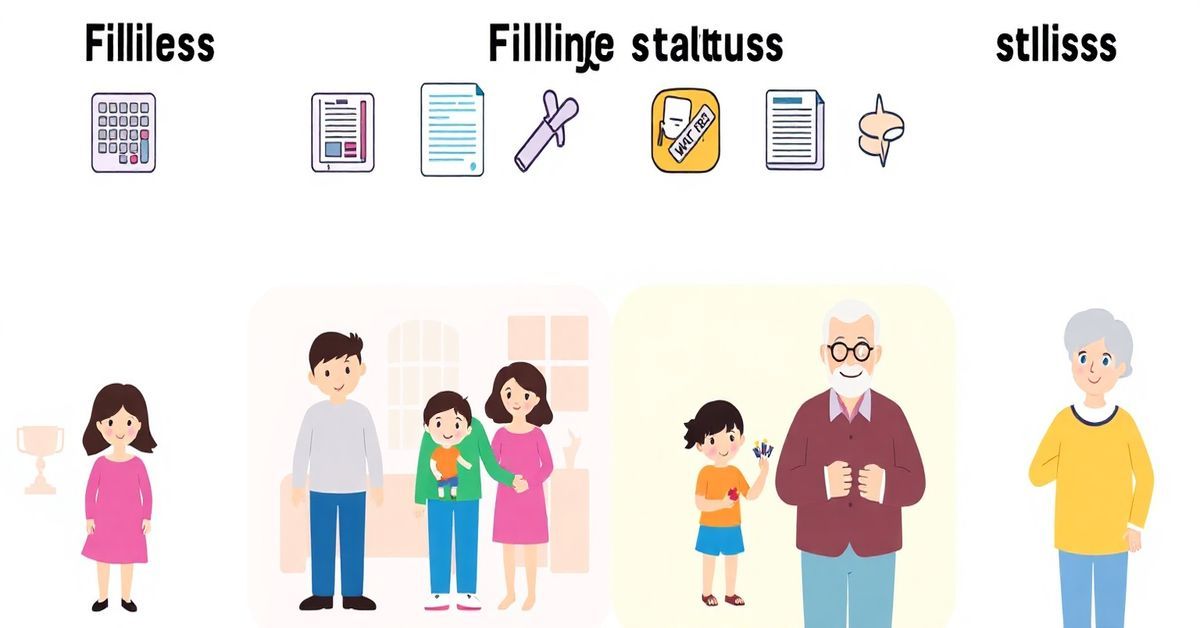Meta-title: What is Filing Status? | Tax Filing Guide
Meta-description: Understand tax filing status options: single, married, head of household & more. Choose correctly for tax benefits. Expert tax advice.
Short Description/Overview: Your filing status determines which tax rates, deductions, and credits you’re eligible for. Choosing the right one is key to minimizing your tax bill.
What is Filing Status and How Does it Affect Your Taxes?
Definition: Filing Status is a category you select on your tax return based on your marital status and family situation. It determines your tax rate, standard deduction, and eligibility for certain tax breaks. The main filing statuses are single, married filing jointly, married filing separately, head of household, and qualifying widow(er).
Understanding Filing Status: A Comprehensive Guide
Choosing the correct filing status isn’t just a formality; it’s a critical step that can significantly impact your tax liability. It affects everything from your tax bracket to the credits and deductions you’re allowed to claim. Let’s dive into the details and explore each option.
Why Does Filing Status Matter?
Imagine filing your taxes without knowing you had an option that could save you money. That’s what can happen if you don’t pay attention to your filing status. This small choice on your tax return has a big impact because:
- Tax Rates: Each filing status has its own tax brackets, determining how much tax you’ll owe at different income levels.
- Standard Deduction: The amount of your income you can deduct without itemizing varies by filing status. This can significantly lower your taxable income.
- Credits and Deductions: Some credits and deductions are only available to specific filing statuses.
- Tax Liability: Ultimately, your filing status plays a major role in determining your overall tax bill.
The Main Filing Status Options: A Detailed Look
Let’s explore each of the primary filing statuses available:
Single
- Who it’s for: This status is for people who are unmarried, divorced, or legally separated according to state law. If you were single on the last day of the tax year (December 31st), this is generally your status.
- How it works: If you are a single filer, you will use the tax rate schedule for “single filers”.
- Example: Sarah is not married and lives alone. She would file as single.
- Things to consider: This is generally the least advantageous status in terms of tax benefits. If there’s any chance you qualify for head of household, be sure to check.
Married Filing Jointly
- Who it’s for: This status is for couples who are legally married as of the last day of the tax year. Both spouses must agree to file jointly.
- How it works: You combine your income and deductions, and you are taxed at a different rate than those who file single, or married filing separately.
- Example: John and Mary are married and choose to file one tax return together. They would file jointly.
- Things to consider: Often provides the most tax benefits, but both parties are jointly liable for the taxes, interest and penalties.
Married Filing Separately
- Who it’s for: This is also for married couples, but they choose to file separate returns.
- How it works: Each spouse reports their own income and deductions. There are sometimes restrictions on the deductions/credits you are able to claim when you file separately.
- Example: David and Lisa are married but prefer to keep their finances separate for various reasons. They each file a separate tax return.
- Things to consider: This status is often less beneficial than filing jointly, but it can be useful in certain situations, like if one spouse has very high medical expenses or student loan debt.
Head of Household
- Who it’s for: This status is for unmarried individuals who pay more than half the costs of keeping up a home for a qualifying child or other qualifying relative. You cannot be considered married as of December 31st, and your child or qualifying relative must live with you for over half of the year.
- How it works: Head of Household filers usually get a larger standard deduction and more favorable tax rates compared to single filers.
- Example: Maria is divorced and lives with her son, whom she financially supports. She files as head of household.
- Things to consider: This status can provide significant tax savings, so it’s important to see if you qualify, especially if you are a single parent.
Qualifying Widow(er) with Dependent Child
- Who it’s for: This is for a surviving spouse whose spouse has passed away, and they have a dependent child, and have not remarried. This status is only available for two years following the year of death of the spouse, and the filer must maintain their home for their dependent child.
- How it works: A Qualifying Widow(er) can use the tax brackets and standard deduction amount for married couples filing jointly.
- Example: Tom’s wife passed away last year. He has a son living with him, and he has not remarried. He can file as Qualifying Widow(er).
- Things to consider: This status provides tax relief during a difficult time but is limited to two years, provided all conditions are met.
How to Choose the Right Filing Status
Choosing the correct filing status requires understanding your personal circumstances. Here’s a simple approach to help you decide:
- Marital Status: Are you single, married, divorced, or legally separated according to state law? This is the first step.
- Dependents: Do you have any children or other relatives who depend on you for financial support?
- Financial Responsibility: Are you paying more than half of the costs of keeping up a home for a qualifying person?
If you’re unsure which status to choose, it’s always a good idea to consult a tax professional. They can assess your specific situation and help you choose the option that will result in the lowest tax liability. The IRS provides resources as well, like the IRS Interactive Tax Assistant.
Common Mistakes and Misconceptions About Filing Status
- Misconception: “I can file as head of household just because I’m single.” This is not true. You must meet specific requirements regarding dependents and financial support.
- Mistake: “It doesn’t matter which status I choose.” It absolutely does! Choosing the wrong status can lead to overpaying your taxes or even penalties.
- Misconception: “Married filing separately is always a bad idea.” While often less beneficial, it can be advantageous in specific situations, so evaluate your circumstances carefully.
- Mistake: Claiming “single” status when you legally separated during the year and have a dependent, because you may qualify for head of household.
Practical Tips for Filing Status
- Check Your Status Every Year: Your situation can change, and your filing status may need to change along with it.
- Keep Records: Maintain records of your financial support of dependents in case the IRS asks for verification.
- Seek Professional Advice: If you’re unsure, consult a tax professional for personalized guidance.
- Use the IRS Resources: Use the IRS website and the interactive tax assistant tool.
Related Tax Terms
- Standard Deduction: The amount of income you can deduct based on your filing status.
- Tax Bracket: The income ranges at which different tax rates are applied.
- Dependent: A qualifying child or relative who meets certain support and residency tests.
- Tax Credits and Deductions: These reduce your tax liability based on specific criteria.
Understanding your filing status is not just about filling out a form. It’s about understanding your rights and responsibilities as a taxpayer and making choices that can save you money.

